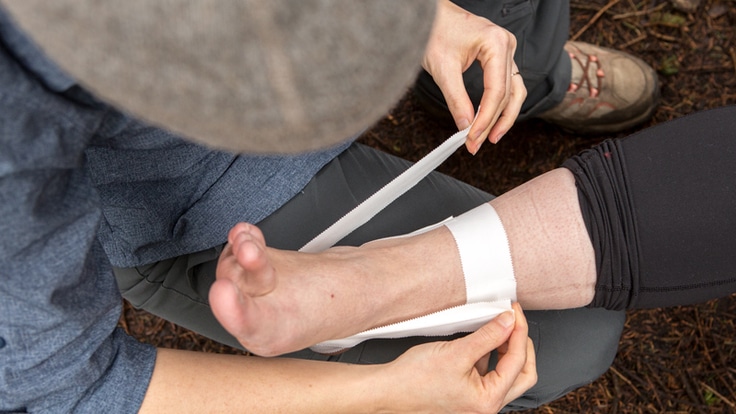To alleviate pain and promote healing, wrapping your dog’s sprained leg can provide support and stability.
Understanding A Dog’s Sprained Leg
A sprained leg in dogs is a common injury that can cause discomfort and pain for our furry friends. Dogs can sprain their legs through various activities such as running, jumping, or a sudden twist. Some common causes of sprained legs in dogs include overexertion, falls, or rough play.
It’s important to recognize the symptoms of a sprained leg, which can include limping, swelling, tenderness, or reluctance to put weight on the affected leg. If you suspect that your dog has a sprained leg, it’s best to consult with a veterinarian for a proper diagnosis and treatment plan.
Wrapping a sprained leg can provide support and stability, but it’s crucial to do it correctly and under veterinary guidance. Taking care of your dog’s sprained leg promptly can help ensure a speedy recovery and prevent further damage.
The Importance Of Proper Care And Treatment For A Sprained Leg
Proper care and treatment for a sprained leg are essential for your dog’s well-being. Timely treatment plays a crucial role in promoting healing and preventing potential risks. If left untreated, a sprained leg can lead to complications and long-term issues.
Immobilization and support are vital in the healing process, providing stability and preventing further damage. Providing the necessary care, such as rest, ice, compression, and elevation, can help reduce pain and swelling. Additionally, consulting a veterinarian is crucial to ensure an accurate diagnosis and appropriate treatment plan.
By taking immediate action and providing proper care, you can help your dog recover faster and minimize any long-term effects of the sprained leg. Remember, the health and happiness of your furry companion depend on your commitment to their well-being.
Effective Techniques For Wrapping A Dog’S Sprained Leg
Wrapping your dog’s sprained leg can aid in the healing process and provide support. Consulting a veterinarian is crucial to ensure an accurate diagnosis and appropriate treatment. Selecting the right materials, such as vet wrap or self-adhesive bandages, is important to prevent discomfort and further injury.
To wrap the leg effectively, follow these step-by-step guidelines: First, gently clean and dry the injured area. Next, apply a layer of non-stick padding over the sprain. Secure the padding with the wrap, making sure it is snug but not too tight.
Continue wrapping in a figure-eight pattern, gradually working down the leg. Be cautious not to wrap too tightly, as this can impair blood circulation. Finally, secure the end of the wrap with tape or fasteners. Regularly monitor your dog’s leg and consult your vet if any complications arise.

Credit: www.rei.com
Alternative Methods For Supporting A Dog’S Sprained Leg
Spraining a dog’s leg can be a painful experience for the furry friend. Luckily, there are alternative methods to consider for added support. Utilizing splints or braces can provide stability and minimize further damage. Orthopedic boots or shoes are also available to protect the injured leg.
Rehabilitation exercises and physical therapy can aid in strengthening the leg and promoting healing. These methods can alleviate discomfort and aid in the dog’s recovery process. It’s important to consult with a veterinarian to determine the best course of action for supporting a dog’s sprained leg.
Following their guidance and utilizing these alternative methods can help the dog regain mobility and lead a happier, healthier life.
Precautions And Considerations When Wrapping A Dog’S Sprained Leg
When faced with a dog’s sprained leg, it’s important to carefully consider whether wrapping at home is the right course of action. While it may seem like a simple solution, there are precautions to keep in mind. One of the key things to avoid is over-tightening the wrap, as this can restrict blood flow and potentially cause more harm.
Additionally, it is important to closely monitor the leg for any signs of infection or worsening condition. If any of these signs are present, it may be time to seek professional help instead of attempting to wrap the leg at home.
By taking these considerations into account, you can ensure the best care for your furry friend’s sprained leg.
Preventive Measures To Reduce The Risk Of Sprained Legs In Dogs
Understanding the importance of exercise and warm-up routines for dogs is crucial in preventing sprained legs. Regular veterinary check-ups and preventive care also play a significant role in maintaining optimal health for our furry friends. By providing a safe and well-maintained environment, we can greatly reduce the risk of accidents.
Ensuring that our dogs have sufficient space to move around freely without any hazards is essential. Additionally, incorporating stretching exercises before intense physical activity can help prepare their muscles for the workout. It is important to note that not all sprained legs can be prevented, but taking these preventive measures can significantly reduce the likelihood of such injuries.
So, should you wrap your dog’s sprained leg? It’s best to consult with a veterinarian to determine the appropriate treatment and management plan for your specific situation.
Conclusion
It is crucial to carefully consider whether or not to wrap your dog’s sprained leg. While wrapping can provide temporary support and protection, it is essential to consult with a veterinarian to determine if it is appropriate for your specific case.
Remember, not all injuries require wrapping, and in some cases, it may even impede the healing process. Working closely with a veterinary professional ensures proper diagnosis, treatment, and healing. Additionally, monitoring your dog’s behavior and keeping them comfortable and restricted during the recovery process is essential.
By following the veterinarian’s advice and providing appropriate care, you can help your furry friend heal faster and prevent further harm. Remember, your dog’s health and well-being should always be the top priority, so trust the experts and give them the best care possible.
